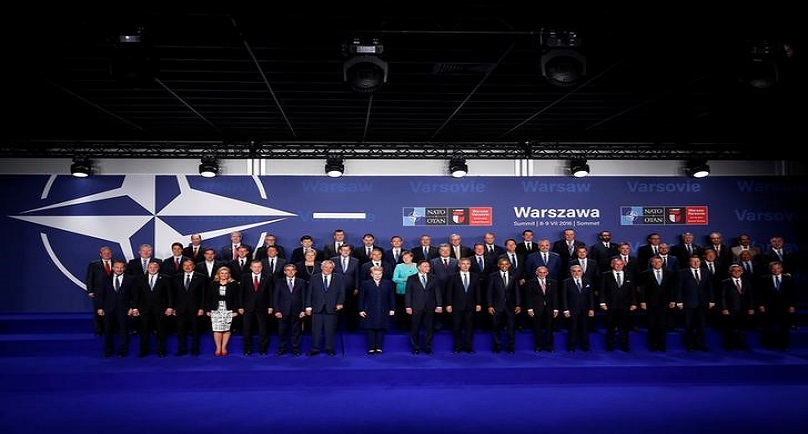Image: NATO heads of state and other leaders participate in a family photo at the NATO Summit in Warsaw, Poland July 8, 2016. REUTERS/Jonathan Ernst
By Robin Emmott and Yeganeh Torbati
WARSAW (Reuters) – NATO took command of a U.S.-built missile shield in Europe on Friday after France won assurances that the multi-billion-dollar system would not be under Washington’s direct control.
The missile shield, billed as a defence against any strike by a “rogue state” against European cities, is one of the most sensitive aspects of U.S. military support for Europe. Russia says the system is in fact intended by Washington to blunt its nuclear arsenal, which the U.S. denies.
“Today we have decided to declare initial operational capability of the NATO ballistic missile defence system,” NATO Secretary-General Jens Stoltenberg told a news conference.
“This means that the U.S. ships based in Spain, the radar in Turkey and the interceptor site in Romania are now able to work together under NATO command and control,” he said, adding that the umbrella was “entirely defensive” and “represents no threat to Russia’s strategic nuclear deterrent”.
Russia is incensed at the show of force by the United States, its Cold War rival in ex-communist-ruled eastern Europe.
Washington hopes handing over control to the multinational NATO alliance can calm Russian fears. European NATO members states are seen as having nothing to gain by provoking Russia, their major energy supplier.
European nations will be responsible for some funding and adding assets to the shield over time.
The system comes as NATO prepares a new deterrent in Poland and the Baltics following Russia’s 2014 annexation of Crimea. In response, Russia is reinforcing its western and southern flanks with three new divisions.
France, which is leading diplomatic efforts with Russia and Germany to bring peace to eastern Ukraine, needed assurances that control of the shield was genuinely being transferred to NATO, not kept under the command of U.S. generals.
SECONDS TO DECIDE
“The key is political control because of the consequences of any interception,” Gen. Denis Mercier, the Frenchman who heads NATO’s command, told Reuters. “The leaders have found a good compromise.”
Military commanders will have only seconds to decide whether to use the shield to try to shoot down a ballistic missile. Officials say NATO will follow rules set down by alliance ambassadors in Brussels.
France was believed to be reluctant to allow U.S. generals too much authority to act in such a missile crisis, fearing that would escalate tensions, although its concerns were never enunciated publicly in detail.
Mercier said the decision to hold another meeting of the NATO-Russia Council, a forum bringing together NATO envoys and Russia at NATO headquarters in Brussels, allowed the alliance to better explain its position to the Kremlin.
“The second thing is dialogue with Russia, to say clearly that this shield is against the proliferation of missile threats, not against one country and especially not against the nuclear capabilities of Russia,” Mercier said.
Russian President Vladimir Putin has said he doubts NATO’s stated aim of protecting the alliance against Iranian rockets, following last year’s historic nuclear deal with Tehran and world powers, which Russia helped to negotiate.
The United States switched on the $800 million missile shield base in Romania in May and will break ground on a final site in Poland due to be ready by late 2018, completing the defence line first proposed almost a decade ago. When fully operational, the defensive umbrella will stretch from Greenland to the Azores.
(Editing by Andrew Roche)
Copyright 2015 Thomson Reuters. Click for Restrictions.


